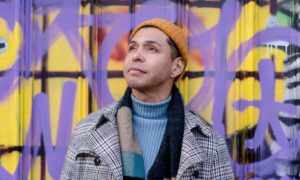Researchers reveal Adam Castillejo still in remission 12 months after ‘cure’ declared.

Adam Castillejo, known in the scientific literature as ‘the London patient’. Photograph: Andrew Testa/New York Times/Redux/eyevine
The patient who became the second person ever to be cleared of HIV remains free of the virus a year after initial reports of a “cure”, researchers have revealed.
Adam Castillejo, who was until Monday known only as the “London patient”, was declared free of HIV last year, 18 months after stopping antiretroviral therapy following a stem cell, or bone marrow, transplant to treat a type of blood cancer.
Timothy Brown, the first person to be cleared of the virus, underwent a similar treatment for acute myelogenous leukaemia. While both Brown and Castillejo had chemotherapy, only Brown had radiotherapy as part of his treatment.
In a paper published in the journal Lancet HIV on Tuesday, researchers say that 30 months after stopping antiretroviral drugs which suppress HIV, and 46 months since the transplant, Castillejo remains in remission.
The team add that, during the period since the last report, they carried out further tests following investigations for a number of medical complaints, enabling them to look for the presence of HIV in a range of tissues.
Not only did they find no detectable active virus – virus capable of replicating – within the blood, but no such virus was found in the cerebrospinal fluid, gut, sperm or lymph nodes, either.
“We propose these findings represent HIV-1 cure,” the authors write.
The team say they found some traces of the virus’s DNA in certain cells, including some white blood cells, but that they are dead ends because they cannot give rise to more of the virus. “What we are detecting is these fossils of virus that can’t go anywhere,” said Prof Ravindra Gupta, of the University of Cambridge, who is the first author of the study.
Castillejo, 40, went public with his identity in an interview with the New York Times, revealing he had been living with HIV since 2003. In 2012 he was diagnosed with Hodgkin lymphoma and subsequently underwent a stem cell transplant. Crucially, the medical team picked a donor whose stem cells had two copies of a mutation that mean the white blood cells they develop into are resistant to HIV.
Last year it emerged the procedure had not only successfully treated the cancer, but that the HIV was in remission. However, he chose to remain anonymous.
“I was watching TV and it’s like: ‘OK, they’re talking about me,’” he told the New York Times. “It was very strange, a very weird place to be.”
Castillejo said he had decided to reveal his identity because he wanted his case to be a cause for optimism. “This is a unique position to be in, a unique and very humbling position,” Castillejo said. “I want to be an ambassador of hope.”
The researchers report that computer models suggest that, 29 months after coming off HIV medication, the chance of Castillejo staying HIV-free is almost certain, provided more than 90% of his stem cells in the bone marrow are donor-derived. At present, it is thought that about 99% of Castillejo’s stem cells are donor-derived.
Gupta said both cases highlighted that HIV could be treated with a less harsh cancer treatment. However, he added, stem cell transplants were not suitable for most people with HIV because they were serious and invasive procedures that carried risks.
At present, patients with HIV can take a pill every day to reduce the levels of the virus in their body, preventing it from being passed on to others and helping them to live a long, healthy and active life.
Nonetheless, Gupta said, the new findings were important. “It is a second case of cure. It means the first one wasn’t an anomaly or a fluke.”
In an article linked to the paper, Dr Jennifer Zerbato and Prof Sharon Lewin of the University of Melbourne and Royal Melbourne hospital, who were not involved in the work, stress it is difficult to define a cure for HIV. They note that the absence of the active virus is potentially a better definition than no trace whatsoever, but say questions remain.
“We will need more than a handful of patients cured of HIV to really understand the duration of follow-up needed and the likelihood of an unexpected late rebound in virus replication.” they write.
In the case of Castillejo, Lewin says, the absence of any active HIV is exciting and encouraging, but whether he is truly cured will only emerge over time, adding that the chance of detecting the intact virus is also dependent on how many samples can be tested.
“It’s hard to know. In the end, only time will tell,” says Lewin, a member of the governing council of the International Aids Society. “But this is looking very promising.”
From The Guardian


